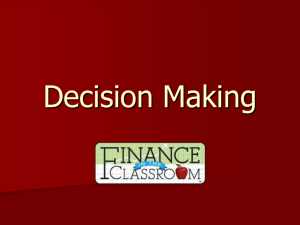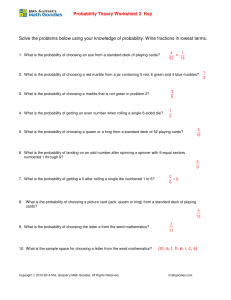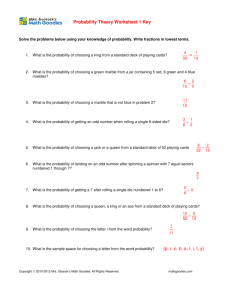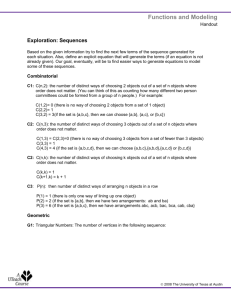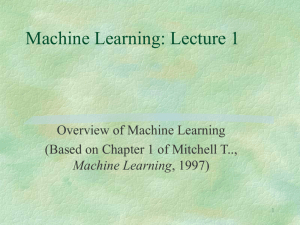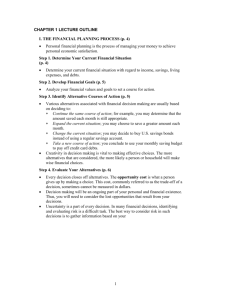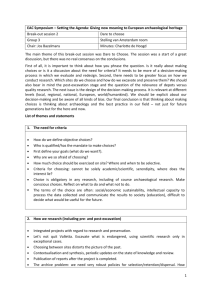The Decision-Making Process
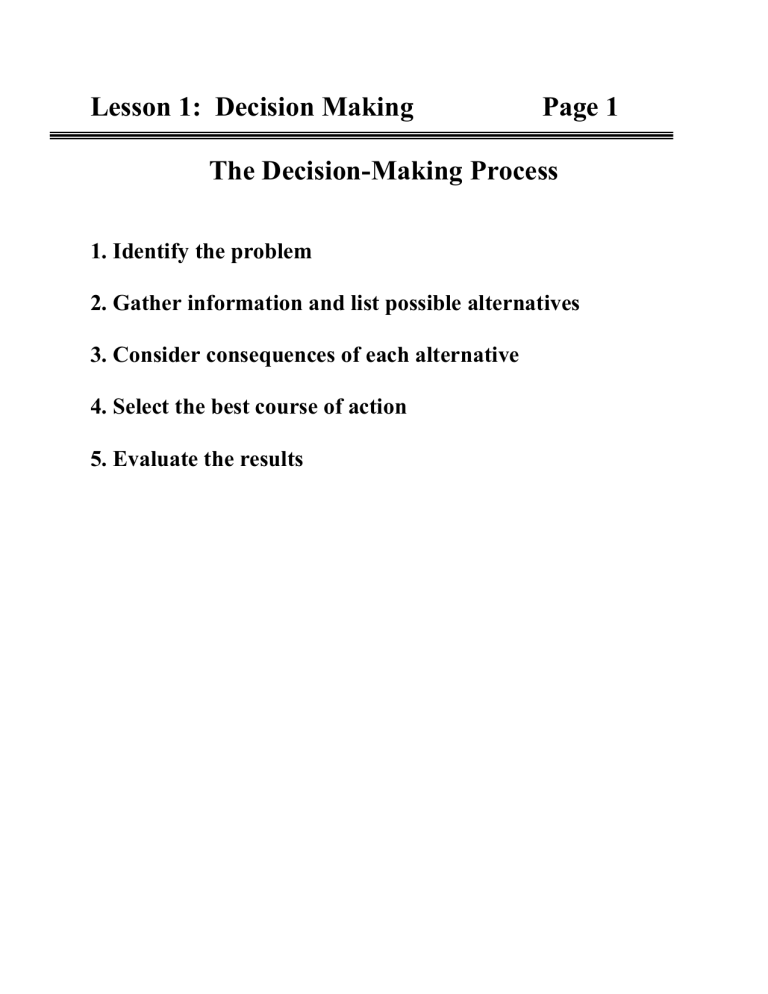
Lesson 1: Decision Making Page 1
The Decision-Making Process
1.
Identify the problem
2.
Gather information and list possible alternatives
3.
Consider consequences of each alternative
4.
Select the best course of action
5.
Evaluate the results
Lesson 1: Making Decisions Page 2
A.
Values
Factors that influence a decision:
What is important to your family or others in your culture?
B.
Peers
People you know
Pressure for positive or negative behaviors
C.
Habits
You are accustomed to doing it this way.
D.
Feelings (love, anger, frustration, ambivalence, rejection)
If you do make a certain decision
If you don't make a certain decision
E.
Family
Your family's preference
Decisions other family members have made
F.
Risks and Consequences
What (or how much) you stand to win
What (or how much) you stand to lose
G.
Age
Minor
Adult
Lesson 1: Making Decisions Page 3
Common Decision-Making Strategies
Spontaneity
Choosing the first option that comes to mind; giving little or no consideration to the consequences of the choice
Compliance
Going along with family, school, work, or peer expectations
Procrastination
Postponing thought and action until options are limited agonizing
Accumulating so much information that analyzing the options becomes overwhelming
intention
Choosing an option that will be both intellectually and emotionally satisfying desire
Choosing the option that might achieve the best result, regardless of the risk involved. avoidance
Choosing the option that is most likely to avoid the worst possible result. security
Choosing the option that will bring some success, offend the fewest people, and pose the least risk. synthesis
Choosing the option that has a good chance to succeed and which you like the best.
Lesson 1: Making Decisions Page 4
Economic Influences on Decision Making
Consumer Prices changes in the buying power of the dollar; inflation
Consumer spending demand for goods and services
Gross Domestic Product (GDP) total value of goods and services produced within the country
Housing Starts the number of new homes being built
Interest Rates the cost of borrowing money
Money Supply funds available for spending in the economy
Stock Market Index
(such as the Dow Jones Averages, Standard &
Poor's 500) indicate general trends in the value of
U. S. stocks
Unemployment the number of people without employment who are willing to work
Lesson 1: Making Decisions Page 5
Risks Associated With Decision Making
Risks are associated with every decision. The following are common risks related to personal and financial decision making:
Personal Risks
Factors that may create a less than desirable situation. Personal risk may be in the form of inconvenience, embarrassment, safety, or health concerns.
Inflation Risk
Rising prices cause lower buying power. Buying an item later may mean a higher price.
Interest-Rate Risk
Changing interest rates affect your costs (when borrowing) and your benefits (when saving or investing).
Income Risk
Changing jobs or reduced spending by consumers can result in a lower income or loss of one’s employment. Career changes or job loss can result in a lower income and reduced buying power.
Liquidity Risk
Certain types of savings (certificates of deposit) and investments (real estate) may be difficult to convert to cash quickly.
Lesson 1: Making Decisions Page 6
Opportunity Costs and the Time Value Of Money opportunity cost refers to what a person gives up when a decision is made. This cost, also called a trade-off, may involve one or more of your resources (time, money, and effort). personal opportunity costs may involve time, health, or energy. For example, time spent on studying usually means lost time for leisure or working. However, this trade-off may be appropriate since your learning and grades will likely improve. financial opportunity costs involve monetary values of decisions made. For example, the purchase of an item with money from your savings means you will no longer obtain interest on those funds. time value of money can be used to measure financial opportunity costs using interest calculations.
For example: spending $1,000 from a savings account paying 4 percent a year means an opportunity cost of $40 in lost interest.
Calculation: $1,000 x .04 (4 percent) x 1 year = $40. Over 10 years, that $40 a year (saved at 4 percent) would have a value of over $480 when taking into account compound interest.
